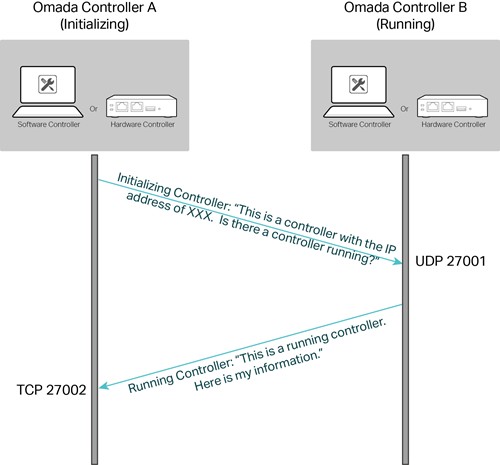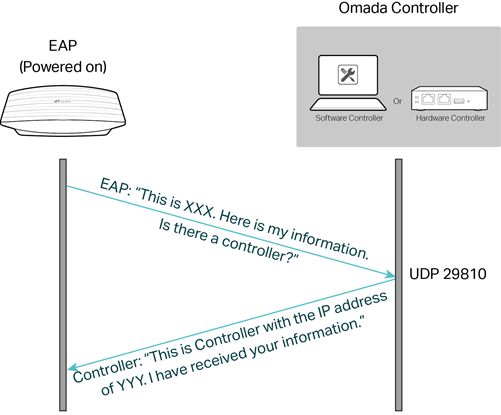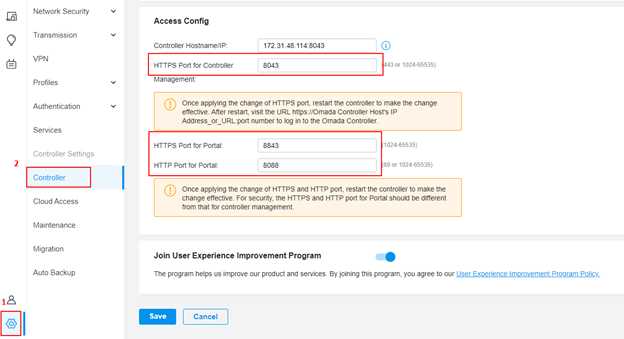개요
프로그램은 특정 포트를 사용하여 네트워크를 통해 데이터를 주고받습니다. Omada 소프트웨어 컨트롤러 또는 EAP 검색 유틸리티는 호스트의 포트를 사용하는 반면, Omada 하드웨어 컨트롤러는 자체 하드웨어의 포트를 사용합니다.
포트는 두 가지 그룹으로 나뉩니다: TCP(전송 제어 프로토콜) 포트 및 UDP(사용자 데이터그램 프로토콜) 포트. 포트 번호는 각 그룹별로 1에서 65535까지로 제한되어 있습니다. 이러한 사실은 프로그램이 호스트의 특정 포트를 사용하려고 할 때 포트 충돌을 발생시키는데, 바로 그 포트가 다른 프로그램에 의해 점유되고 있는 것을 발견할 수 있습니다.
이 문서에서는 Omada 컨트롤러와 EAP 검색 유틸리티가 사용하는 포트와 포트 관련 문제가 발생했을 때 이를 해결하는 방법에 대해 설명합니다.
참고:
Omada SDN Controller V5 또는 Omada Discovery Utility V5를 사용하는 경우 다른 FAQ를 참조하세요: Omada SDN 컨트롤러와 Omada Discovery 유틸리티는 어떤 포트를 사용하나요? (컨트롤러 5.0.15 이상)
기본 포트 개요
Omada 컨트롤러와 EAP 검색 유틸리티가 기본적으로 사용하는 포트는 다음 표에 나와 있습니다.
|
포트 |
Omada 하드웨어 컨트롤러 |
Omada 소프트웨어 컨트롤러 |
EAP Discovery Utility |
포트가 필요한 경우 |
|
|
웹 관리 및 포털 |
|||||
|
TCP 80 |
✔ |
|
|
1. 브라우저에서 'http' 연결을 통해 Omada 컨트롤러의 관리 페이지가 열립니다. 2. 사용자는 v4.x 이전에는 HTTP 포털을 통해 인증되었습니다. |
|
|
TCP 443 |
✔ |
|
|
1. 브라우저에서 'https' 연결을 통해 Omada 컨트롤러의 관리 페이지가 열립니다. 2. 사용자는 v4.x 이전에는 HTTPS 포털을 통해 인증되었습니다. 3. Omada 컨트롤러는 v5.x 이후 Omada 장치를 업그레이드합니다. |
|
|
TCP 8088 |
✔ |
✔ |
|
1. 브라우저에서 Omada 소프트웨어 컨트롤러의 "http" 연결을 통해 Omada 컨트롤러의 관리 페이지가 열립니다. 2. 사용자는 소프트웨어 컨트롤러 및 하드웨어 컨트롤러 v4.x 이상용 HTTP 포털을 통해 인증됩니다. |
|
|
TCP 8043 |
|
✔ |
|
1. 브라우저에서 'https' 연결을 통해 Omada 컨트롤러의 관리 페이지가 열립니다. 2. 사용자는 v4.x 이전 버전의 소프트웨어 컨트롤러용 HTTPS 포털을 통해 인증됩니다. 3. Omada 컨트롤러는 v5.x 이후 Omada 장치를 업그레이드합니다. |
|
|
TCP 8843 |
✔ |
✔ |
|
사용자는 컨트롤러 v4.x 이상용 HTTPS 포털을 통해 인증됩니다. |
|
|
EAP 검색, 채택, 관리 및 업그레이드 |
|||||
|
UDP 29810 |
✔ |
✔ |
✔ |
Omada 컨트롤러 또는 EAP 검색 유틸리티는 Omada 디바이스를 검색합니다. |
|
|
TCP 29811/29812 |
✔ |
✔ |
✔ |
Omada 컨트롤러 또는 EAP 검색 유틸리티는 Omada 컨트롤러 v5.x 이전의 Omada 장치를 관리합니다. |
|
|
TCP 29813 |
✔ |
✔ |
|
Omada 컨트롤러는 Omada 컨트롤러 v5.x 이전의 Omada 장치를 업그레이드합니다. |
|
|
TCP 29814 |
✔ |
✔ |
✔ |
Omada 컨트롤러 또는 EAP 검색 유틸리티는 Omada 컨트롤러 v5.x부터 Omada 장치를 채택합니다. |
|
|
초기화 확인 |
|||||
|
UDP 27001* |
✔ |
✔ |
|
1. 소프트웨어 컨트롤러는 Omada 컨트롤러 v4.x 이전에 LAN에서 다른 컨트롤러가 실행 중인지 여부를 검색합니다. 2. Omada 앱은 Omada 컨트롤러 v4.x 이후 컨트롤러가 LAN에서 실행 중인지 여부를 검색합니다. |
|
|
TCP 27002* |
✔ |
✔ |
|
소프트웨어 컨트롤러는 Omada 컨트롤러 v3.2.4 및 이전 버전에 대해 LAN의 다른 컨트롤러에 대한 정보를 수집합니다. |
|
|
데이터베이스 액세스 |
|||||
|
TCP 27017 |
|
✔ |
|
소프트웨어 컨트롤러는 v3.x 이전 컨트롤러용 기본 제공 데이터베이스에 액세스합니다. |
|
|
TCP 27217 |
|
✔ |
|
소프트웨어 컨트롤러는 컨트롤러 v3.x 이상에 내장된 데이터베이스에 액세스합니다. |
|
참고: UDP 27001 및 TCP 27002는 컨트롤러 소프트웨어 V3.2.4 이하에서만 초기화 검사 중에 사용됩니다. 컨트롤러 소프트웨어 V3.2.5 이상의 경우, Omada 컨트롤러는 LAN의 다른 컨트롤러를 확인하지 않고 초기화됩니다.
포트를 사용하는 Omada 컨트롤러의 예
이 섹션에서는 두 가지 예를 들어 Omada 컨트롤러가 포트를 사용하는 방법을 설명합니다.
Omada 컨트롤러가 초기화되면 LAN에서 다른 컨트롤러가 실행되고 있지 않은지 확인해야 합니다. 그렇지 않으면 초기화를 중지하고 대신 실행 중인 컨트롤러의 웹 페이지를 시작합니다. 다음 그림과 표에 표시된 대로 대화가 진행됩니다.

|
1단계 |
초기화 컨트롤러는 LAN에 있는 모든 호스트의 UDP 포트 27001로 자기 소개 메시지를 보냅니다. 실행 중인 컨트롤러가 있는 경우 포트에서 수신 대기하고 메시지를 수신합니다. |
|
2단계 |
실행 중인 컨트롤러는 자신에 대한 정보를 초기화 컨트롤러의 TCP 포트 27002로 전송합니다. |
참고: UDP 27001 및 TCP 27002는 컨트롤러 소프트웨어 V3.2.4 이하에서만 초기화 검사 중에 사용됩니다. 컨트롤러 소프트웨어 V3.2.5 이상의 경우, Omada 컨트롤러는 LAN의 다른 컨트롤러를 확인하지 않고 초기화됩니다.
- Omada 컨트롤러가 EAP를 발견한 경우
EAP의 전원이 켜지고 LAN의 Omada 컨트롤러가 이를 검색할 수 있습니다. 다음 그림과 표에 표시된 대로 대화가 진행됩니다.

|
1단계 |
EAP는 컨트롤러의 위치를 정확히 알 수 없으므로 LAN에 있는 모든 호스트의 UDP 포트 29810으로 자기 소개 메시지를 보냅니다. |
|
2단계 |
Omada 컨트롤러는 포트를 수신하고 메시지를 수신한 후 동일한 포트를 통해 EAP에 응답합니다. |
Omada 소프트웨어 컨트롤러에서 사용하는 포트를 변경하는 방법
예를 들어, PC의 일부 프로그램이 Omada 컨트롤러와 동일한 포트를 사용하여 컨트롤러가 제대로 작동하지 않는 경우와 같이 필요한 경우 Omada 소프트웨어 컨트롤러에서 사용하는 포트의 일부를 변경할 수 있습니다.
- 컨트롤러 v3.x
소프트웨어 컨트롤러를 설치한 경로를 검색합니다. 속성 하위 폴더로 들어가서 다음 표에 따라 필요한 포트가 설정된 구성 파일과 항목을 찾습니다.
|
파일 |
포트 설정 |
|
mongodb.properties |
eap.mongod.port=27217* |
|
jetty.properties |
http.connector.port=8088* https.connector.port=8043* |
|
netty.properties |
controller.discovery.port=27001* controller.search.port=27002 eap.discovery.port=29810* eap.manage.port=29811* eap.adopt.port=29812* eap.upgrade.port=29813 |
참고:
1. TCP 27217은 컨트롤러 소프트웨어 V3.0.0 이상에서 기본 제공 데이터베이스에 액세스하는 데 사용됩니다. 컨트롤러 소프트웨어 V3.0.0 이전에는 TCP 27017이 대신 사용되었습니다.
2. http.connector.port 8088 또는 https.connector.port 8043을 변경하면 포털 인증 프로세스에서 사용되는 포트도 그에 따라 변경됩니다.
3. Omada 소프트웨어 컨트롤러 V3.2.4 이하 버전의 경우 LAN에서 여러 대의 Omada 컨트롤러를 사용하려면 controller.discovery.port 27001을 변경해 보세요.
4. 포트 29810, 29811 및 29812는 EAP 검색, 채택 및 관리를 위해 필요합니다. Omada 장치는 이러한 포트에서 작동하도록 되어 있으므로 변경하지 마세요.
- 컨트롤러 v4.x
Omada 소프트웨어 컨트롤러는 웹 인터페이스에서 웹 관리 및 포털에 사용되는 포트 번호 변경을 지원합니다.
설정 -> 컨트롤러 -> 액세스 구성으로 이동하면 세 가지 포트를 변경할 수 있습니다: 컨트롤러용 HTTPS 포트, 포털용 HTTPS 포트 및 포털용 HTTP 포트. 포트 번호 수정은 컨트롤러를 재시작한 후에 적용됩니다.

또한 컨트롤러의 HTTP 포트와 기본 제공 데이터베이스에 액세스하기 위한 포트(기본값은 8088 및 27217)를 변경할 수도 있습니다.
소프트웨어 컨트롤러를 설치한 경로를 검색합니다. 속성 하위 폴더에 들어가면 omada.properties 파일에서 이 두 포트를 변경할 수 있습니다,
manage.http.port=8088
eap.mongod.port=27217
이 문서에는 기계 번역이 적용되었으며, 정확한 내용을 확인하려면 원본 영문 문서를 참고하시기 바랍니다.








